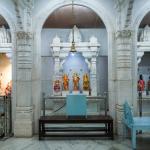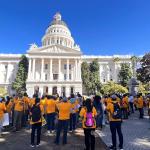I have read a lot of Inspirational stories… but this one – a real one – one of the greatest one that I have read. It shows how a group of teenagers defied all odds and won with a robot made of PVC, blue, garish paints.. .”Most Best Tampons” .. and lot of grit!!
The competition required students to build a robot that could survey a sunken mock-up of a submarine
The story should actuall be made into a movie.. seriously. It also shows how important focus and motivation is. These two triumph against the best of brains! I have always held that to succeed three things are important in life –
- Focus
- Hard-work
- Intelligence
.. in that order.. and “Intelligence” is the least important of all! This is a MUST READ!!!
The winter rain makes a mess of West Phoenix. It turns dirt yards into mud and forms reefs of garbage in the streets. Junk food wrappers, diapers, and Spanish-language porn are swept into the gutters. On West Roosevelt Avenue, security guards, two squad cars, and a handful of cops watch teenagers file into the local high school. A sign reads: Carl Hayden Community High School: The Pride’s Inside.
There certainly isn’t a lot of pride on the outside. The school buildings are mostly drab, late ’50s-era boxes. The front lawn is nothing but brown scrub and patches of dirt. The class photos beside the principal’s office tell the story of the past four decades. In 1965, the students were nearly all white, wearing blazers, ties, and long skirts. Now the school is 92 percent Hispanic. Drooping, baggy jeans and XXXL hoodies are the norm.
The school PA system crackles, and an upbeat female voice fills the bustling linoleum-lined hallways. “Anger management class will begin in five minutes,” says the voice from the administration building. “All referrals must report immediately.”
Across campus, in a second-floor windowless room, four students huddle around an odd, 3-foot-tall frame constructed of PVC pipe. They have equipped it with propellers, cameras, lights, a laser, depth detectors, pumps, an underwater microphone, and an articulated pincer. At the top sits a black, waterproof briefcase containing a nest of hacked processors, minuscule fans, and LEDs. It’s a cheap but astoundingly functional underwater robot capable of recording sonar pings and retrieving objects 50 feet below the surface. The four teenagers who built it are all undocumented Mexican immigrants who came to this country through tunnels or hidden in the backseats of cars. They live in sheds and rooms without electricity. But over three days last summer, these kids from the desert proved they are among the smartest young underwater engineers in the country.
It was the end of June. Lorenzo Santillan, 16, sat in the front seat of the school van and looked out at the migrant farmworkers in the fields along Interstate 10. Lorenzo’s face still had its baby fat, but he’d recently sprouted a mustache and had taken to wearing a fistful of gold rings, a gold chain, and a gold medallion of the Virgin Mary pierced through the upper part of his left ear. The bling wasn’t fooling anyone. His mother had been fired from her job as a hotel maid, and his father had trouble paying the rent as a gardener. They were on the verge of eviction for nonpayment of rent. He could see himself having to quit school to work in those fields.
“What’s a PWM cable?” The sharp question from the van’s driver, Allan Cameron, snapped Lorenzo out of his reverie. Cameron was the computer science teacher sponsoring Carl Hayden’s robotics program. At 59, he had a neatly trimmed white beard, unkempt brown hair, and more energy than most men half his age. Together with his fellow science teacher Fredi Lajvardi, Cameron had put up flyers around the school a few months earlier, offering to sponsor anyone interested in competing in the third annual Marine Advanced Technology Education Center’s Remotely Operated Vehicle Competition. Lorenzo was one of the first to show up to the after-school meeting last spring.
Cameron hadn’t expected many students to be interested, particularly not a kid like Lorenzo, who was failing most of his classes and perpetually looked like he was about to fall asleep. But Lorenzo didn’t have much else to do after school. He didn’t want to walk around the streets. He had tried that – he’d been a member of WBP 8th Street, a westside gang. When his friends started to get arrested for theft, he dropped out. He didn’t want to go to jail.
That’s why he decided to come to Cameron’s meeting.
“PWM,” Lorenzo replied automatically from the van’s passenger seat. “Pulse width modulation. Esto controls analog circuits with digital output.”
Over the past four months, Lorenzo had flourished, learning a new set of acronyms and raising his math grade from an F to an A. He had grown up rebuilding car engines with his brother and cousin. Now he was ready to build something of his own. The team had found its mechanics man.
Ever since his younger sister demanded her own room four years ago, Cristian Arcega had been living in a 30-square-foot plywood shed attached to the side of his parents’ trailer. He liked it there. It was his own space. He was free to contemplate the acceleration of a raindrop as it leaves the clouds above him. He could hear it hit the roof and slide toward the puddles on the street outside. He imagined that the puddles were oceans and that the underwater robot he was building at school can explore them.
Cameron and Ledge, as the students called Lajvardi, formed the robotics group for kids like Cristian. He was probably the smartest 16-year-old in West Phoenix – without even trying, he had one of the highest GPAs in the school district. His brains and diminutive stature (5’4″, 135 pounds) kept him apart at Carl Hayden. That and the fact that students socialized based on Mexican geography: In the cafeteria, there were Guanajuato tables and Sonora tables. Cristian was from Mexicali, but he’d left Mexico in the back of a station wagon when he was 6. He thought of himself as part American, part Mexican, and he didn’t know where to sit.
So he ate lunch in the storage room the teachers had commandeered for the underwater ROV club. Cristian devoted himself to solving thrust vector and power supply issues. The robot competition (sponsored in part by the Office of Naval Research and NASA) required students to build a bot that could survey a sunken mock-up of a submarine – not easy stuff. The teachers had entered the club in the expert-level Explorer class instead of the beginner Ranger class. They figured their students would lose anyway, and there was more honor in losing to the college kids in the Explorer division than to the high schoolers in Ranger. Their real goal was to show the students that there were opportunities outside West Phoenix. The teachers wanted to give their kids hope.
Just getting them to the Santa Barbara contest in June with a robot would be an accomplishment, Cameron thought. He and Ledge had to gather a group of students who, in four months, could raise money, build a robot, and learn how to pilot it. They had no idea they were about to assemble the perfect team.
“We should use glass syntactic flotation foam,” Cristian said excitedly at that first meeting. “It’s got a really high compressive strength.”
Cameron and Ledge looked at each other. Now they had their genius.
Oscar Vazquez was a born leader. A senior, he’d been in ROTC since ninth grade and was planning on a career in the military. But when he called to schedule a recruitment meeting at the end of his junior year, the officer in charge told him he was ineligible for military service. Because he was undocumented – his parents had brought him to the US from Mexico when he was 12 – he couldn’t join, wouldn’t get any scholarships, and had to start figuring out what else to do with his life. Oscar felt aimless until he heard about the robot club from Ledge, who was teaching his senior biology seminar. Maybe, he thought, engineering could offer him a future.
ROTC had trained Oscar well: He knew how to motivate people. He made sure that everyone was in the room and focused when he phoned Frank Szwankowski, who sold industrial and scientific thermometers at Omega Engineering in Stamford, Connecticut. Szwankowski knew as much about thermometer applications as anyone in the US. All day long, he talked to military contractors, industrial engineers, and environmental consultants. So he was momentarily confused when he heard Oscar’s high-pitched Mexican accent on the other end of the line. The 17-year-old kid from the desert wanted advice on how to build a military-grade underwater ROV.














